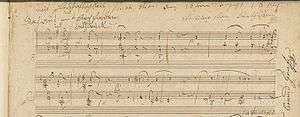Piano Sonata No. 27 (Beethoven)

Ludwig van Beethoven's Piano Sonata No. 27 in E minor, Op. 90 was written in the summer of 1814 – Beethoven's late Middle period – and was dedicated to Prince Moritz von Lichnowsky, a friend and benefactor who was also the dedicatee of the famous Eroica Variations.
History of composition
Beethoven's previous piano sonata, popularly known as Les Adieux, was composed almost five years prior to Op. 90. Beethoven's autograph survives and is dated August 16. The sonata was published almost a year later, in June 1815, by S. A. Steiner, after a few corrections were made by Beethoven.[1] Beethoven's letter to Prince Moritz von Lichnowsky, sent in September 1814, explains Beethoven's dedication:
I had a delightful walk yesterday with a friend in the Brühl, and in the course of our friendly chat you were particularly mentioned, and lo! and behold! on my return I found your kind letter. I see you are resolved to continue to load me with benefits. As I am unwilling you should suppose that a step I have already taken is prompted by your recent favors, or by any motive of the sort, I must tell you that a sonata of mine is about to appear, dedicated to you. I wished to give you a surprise, as this dedication has been long designed for you, but your letter of yesterday induces me to name the fact. I required no new motive thus publicly to testify my sense of your friendship and kindness.[2]
Beethoven's friend and biographer Anton Schindler reported that the two movements of the sonata were to be titled Kampf zwischen Kopf und Herz ("A Contest Between Head and Heart") and Conversation mit der Geliebten ("Conversation with the Beloved"), respectively, and that the sonata as a whole referred to Prince Moritz' romance with a woman he was thinking of marrying.[3] Schindler's explanation first appeared in his 1842 book Beethoven in Paris and has been repeated in several other books. Later studies showed that the story was almost certainly invented by Schindler, at least in part, and that he went as far as to forge an entry in one of Beethoven's conversation books to validate the anecdote.[4]
Form
Although most of Beethoven's piano sonatas are cast in three or four movements, this piece consists of just two movements. Both are provided with performance instructions in German. A few of Beethoven's works of this period carried similar instructions in place of the traditional Italian tempo markings.
- Mit Lebhaftigkeit und durchaus mit Empfindung und Ausdruck ("With liveliness and with feeling and expression throughout")
- Nicht zu geschwind und sehr singbar vorgetragen ("Not too swiftly and conveyed in a singing manner")
The first movement, in E minor, is written in a 3
4 time. The restless character of the music has been noted by many commentators, including Donald Francis Tovey, who described the movement as one "full of passionate and lonely energy",[5] and Charles Rosen, who wrote of the "despairing and impassioned" mood.[6] The movement is cast in sonata form in which the exposition is not repeated, and the development section is based almost entirely on the first subject.
The second movement is a gentle sonata-rondo movement in E major (the tonic major) and a 2
4 time signature. Its Romantic character, with foreshadows Schubert's style in particular, has long been noted by numerous musicians and musicologists, e.g. William Kinderman,[7] Barry Cooper,[8] and Charles Rosen – the latter considered the main melody to be "exquisitely beautiful" and an example of Beethoven's most accomplished melodies.[9]
A full performance of the sonata takes about 13-14 minutes. There are no repeats in either movement.
At the time Beethoven composed the sonata, the lowest note on the piano was an F. This posed a challenge for a work in the key of E, as the bass end of the instrument fell one semitone short of the tonic. Charles Rosen argued that a performer on a modern piano should make alterations to Beethoven's score to utilise the low E that Beethoven could not.[10]
Media
 |
Piano Sonata 27, Op. 90 - 1. Mit Lebhaftigkeit und durchaus mit Empfindung und Ausdruck
Performed by Randolph Hokanson Piano Sonata 27, Op. 90 - 2. Nicht zu geschwind und sehr singbar vorgetragen
Performed by Randolph Hokanson |
| Problems playing these files? See media help. | |
References
- ↑ Letters 152–153, in: Beethoven's Letters 1790–1826, Vols. 1–2., translated by Lady Wallace. New York: C.H. Ditson & Co.
- ↑ Letter 131, in: Beethoven's Letters 1790–1826, Vols. 1–2., translated by Lady Wallace. New York: C.H. Ditson & Co.
- ↑ Grove, George. Beethoven and his Nine Symphonies, p. 314. Cambridge University Press, 2014. ISBN 978-1-108068581
- ↑ Clive, H. P. Beethoven and His World: A Biographical Dictionary, p. 207. Oxford University Press, 2001. ISBN 978-0-198166726
- ↑ Tovey, Donald Francis (1998). A Companion to Beethoven's Pianoforte Sonatas, rev. ed. ABRSM Publishing, London. p. 198.
- ↑ Rosen, Charles (1997). The Classical Style. W.W. Norton & Co. p. 210. ISBN 978-0393317121.
- ↑ Kinderman, William. Beethoven, pp. 180n–182. Oxford University Press; 2 edition. ISBN 978-0195328363
- ↑ Cooper, Barry. Beethoven (in Master Musicians), p. 232. Oxford University Press, 2008. ISBN 978-0195313314
- ↑ Rosen, Charles (1997). The Classical Style. W.W. Norton & Co. pp. 394, 403–404. ISBN 978-0393317121.
- ↑ Rosen, Charles (2002). Beethoven's Piano Sonatas: A Short Companion, Volume 1. Yale University Press. p. 210. ISBN 0300090706.
External links
- A lecture by András Schiff on Beethoven's piano sonata op. 90
- Piano Sonata No. 27: Scores at the International Music Score Library Project